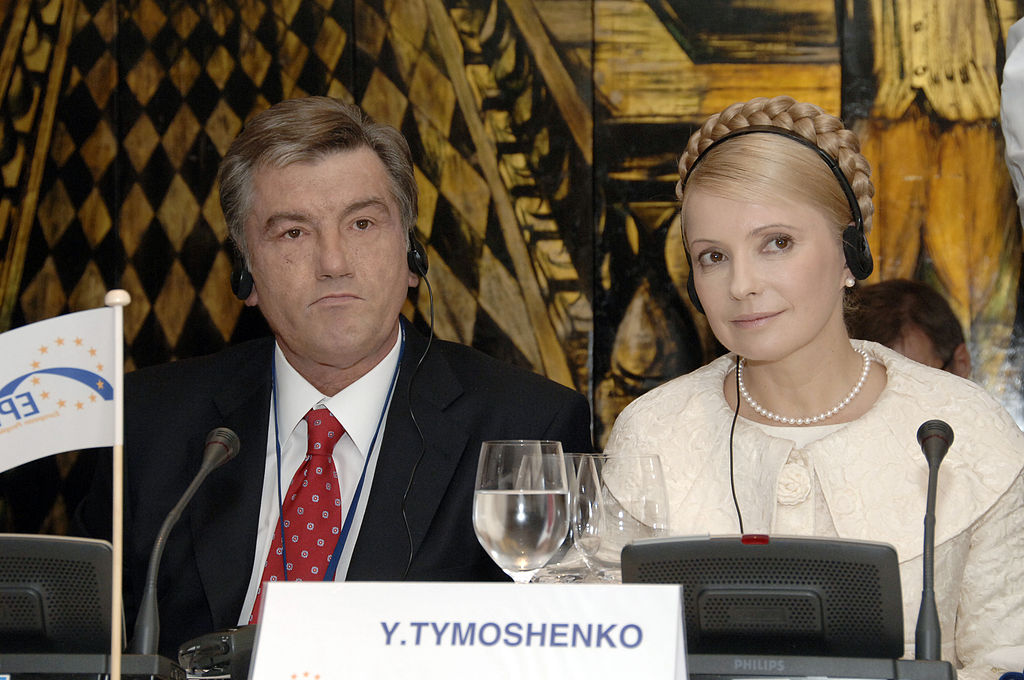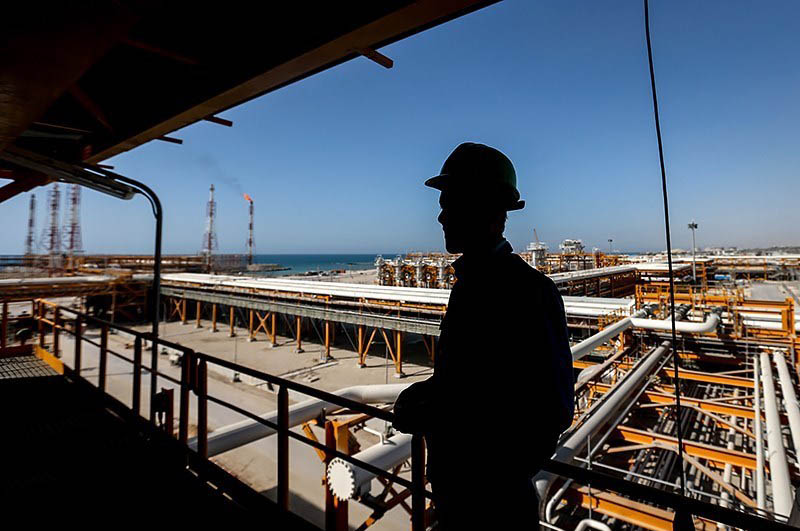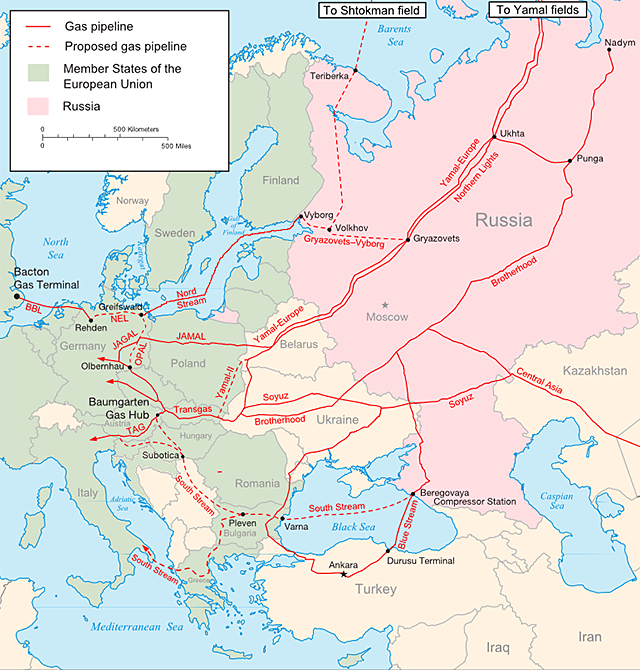After the collapse of the Soviet Union, post-Soviet privatization began with the demands of the ‘market-oriented West’: primary Russian strategic industrial assets must be divided and sold on the global stock market. And the West, on the whole, achieved success in this already in the Yeltsin era.
What we are witnessing today is another and the most severe escalation of the global economic war in the post-Soviet history. And this is taking place with a new Cold War directly and explicitly declared exactly against Russia. And one of the most important fronts of this war at present is the ‘gas front’. Why?
First of all, because Russia, albeit very much weakened in comparison with the Soviet times, has managed to retain one of the most important economic (and hence political) instruments of global influence – a huge part of control over the global gas market. And one of the major objectives of the Western world (and, above all, of the USA) in a new Cold War is to take away this ‘global economic weapons’ from Russia.
Milestones of the post-Soviet ‘gas war’
It is not for the first time when such an attempt is made. After the collapse of the Soviet Union, post-Soviet privatization began with the demands of the ‘market-oriented West’: primary Russian strategic industrial assets must be divided and sold on the global stock market. First of all, it had to be those assets which form the key export revenues of the state. And the West, on the whole, achieved success in this already in the Yeltsin era.
Oil production and refining in Russia is mainly controlled by non-governmental companies with, as a rule, a very significant share of foreign owners in the capital stock.
The lion’s share of Russian metallurgy and fertilizer industries is not under the control of the Russian state for a long time now.
In the new XXI century, the most important Russian infrastructure monopoly, OAO RAO Unified Energy System of Russia was fragmented and privatized (it controlled about 70% of Russia’s installed electric capacity, 96% of its high-voltage grid, over 70% of its transmission lines and exported electricity to Scandinavia and the Commonwealth of Independent States – Editor).
And only the huge “gas” wealth of Russia – the largest reserves of natural gas in the world, as well as the trunk pipeline network to transport gas to customers in the country and to export it to the world markets – remains under the state control. The Western world and its supporters in Russia did not like it much and still doesn’t.
Let us recall repeated attempts to fragment Gazprom or, at least, to split its production capacities and trunk pipeline network into ‘independent corporations.’
Let us recall the schemes of notorious Bill Browder and his accomplice Magnitsky, who managed to buy up, illegally, about 7% of Gazprom shares through shell companies. And they were hoping, together with other Western allies, to increase their share in the Russian gas corporation to a blocking stake (25%) or even to a controlling stake (50%).
These attempts failed so far. And Gazprom is still a key state controller of the Russian gas production and gas export despite the emergence of several large non-governmental gas production companies in Russia. Therefore, Gazprom not only provides a significant part of the revenue in the national budget, but also ensures a great (around 30% of gas import in the EU!) economic influence of Russia on Europe.
Trunk pipelines built in the Soviet times become a cornerstone of the influence of Russia on the European gas market.
After the collapse of the Soviet Union, the most important pipelines are ‘Union’ and ‘Yamal-Europe’. ‘Union’ is two branches that pass through the territory of Ukraine and transport gas to Slovakia and Western Europe, as well as to Moldova, Romania, Bulgaria, Turkey. ‘Yamal-Europe’ is a branch passing through Belarus and delivering gas to Poland and then to Germany.
Both ‘Union’ and ‘Yamal-Europe’ were built not only and not so much for gas supply of Eastern European allies of the USSR as for the gas export of the Soviet Union to Western Europe – Germany, Austria, France, and Italy to begin with. It must be emphasized that the construction of ‘Union’ and ‘Yamal-Europe’ was of high interest to these countries and was supported by them. This interest was high even in the most ‘hot’ moments of the past Cold War at the times of US President Ronald Reagan.
After the dissolution of the Soviet Union, European demands for gas were nevertheless growing. And Russia was the closest large gas supplier, which permanently demonstrated its absolute predictability and reliability. Therefore, European countries and companies (especially the main ‘Europe’s growth locomotive’ – Germany) raised the matter of rising of Russian gas export in the mid 90s of the last century.
By that time, it was also evident that the policy of the main transit countries of Russian gas to the West, Poland and especially Ukraine, toward Russia became hardly predictable and sometimes openly blackmailing. Small gas conflicts between Ukraine and Russia had already occurred in 1993-1996.
Exactly at that time was born the project of the new gas pipeline ‘Nord Stream’ from Russia directly to Germany across the Baltic Sea to bypass all the transit countries. And exactly at that time, the second pipeline project to bypass Ukraine was born; it was the gas pipeline ‘Blue Stream’ from Russia to Turkey across the Black Sea.
Agreement on the construction of the “Blue Stream” was signed in December 1997. The pipeline with the capacity of 16 billion cubic meters of gas per annum started working in 5 years, in December 2002.
‘Nord Stream’ was also announced in 1997 though it was completed only in 2011-2012, after many attempts of Poland, the Baltic States, with the support of the USA, to torpedo the project on the environmental and other phony grounds. Two lines of ‘Nord Stream’ can deliver almost 60 billion cubic meters of gas per annum to Europe. Germany and other project participants (German BASF and E.ON Ruhrgas, Dutch Gasunie, French GDF Suez) only made their final decision to actively support and fund ‘Nord Stream’ after Yushchenko’s ‘Orange Revolution’ in Ukraine in 2004–2005 provoked by the United States, that is to say, the project participants began to seriously doubt the reliability of the transit of Russian gas purchased by Europe through Ukrainian
gas pipeline ‘Union’.
The first major Russia-Ukraine gas dispute occurred in winter 2005–2006. Back then Ukraine demanded to increase sharply the cost (‘up to the European market price’) of Russian gas transit to Europe for Gazprom. And at the same time, Kiev refused to fulfill Gazprom’s condition: to increase in the price of Russian gas for Ukraine (also up to the ‘European market price’).
As a result, Moscow cut off gas supplies to Ukraine for several days, and Kiev in response began to divert the gas intended to be exported to Europe from the pipeline. This conflict was quickly settled through compromise as to the cost of transit and the price of gas though the Europeans remained extremely concerned.
Exactly at that time, the concerned Western countries increased their activity in making ‘Nord Stream’ happen. At approximately the same time EU started to discuss the idea of an alternative gas pipeline Nabucco-West from Turkmenistan across the Caspian Sea, Azerbaijan and Georgia to Turkey and further to Europe.
The second major gas conflict, essentially, in the same format started in winter of 2008–2009 as a result of the dispute over intermediation services of Swiss-registered venture company RosUkrEnergo, which traded gas between Russia and Ukraine since 2006.
RosUkrEnergo owned by Gazprom and Ukrainian businessmen Dmitry Firtash and Ivan Fursin supplied Ukraine with more expensive Russian gas and cheaper Turkmen gas though in a mixture of non-transparent proportions (and, as recognized by many experts, with large price fraud). Ukraine, being in an economic crisis, withheld the payment of gas, thus, increasing its debts to Gazprom.
In December 2008, Ukrainian President Viktor Yushchenko acknowledged the country’s debt of $2.4 billion to Gazprom. However, the Prime Minister Yulia Tymoshenko refused to pay the debt by saying that it was not the debt of Ukraine, but of RosUkrEnergo. Moscow (and the then President Dmitry Medvedev and Prime Minister Vladimir Putin) insisted on trading without intermediary and directly with the state-owned company Naftogaz of Ukraine.

However on December 31st, Viktor Yushchenko withdrew the Ukrainian delegation from the negotiations with Gazprom. And from 1st January 2009, Russia cut off supplies of gas to Ukraine. Kiev once again resorted to the stealing European gas transit. Europe started to freeze.
The dispute was settled in three weeks, on January 20th. However, Europe remembered the horror of ceasing of gas supplies in the middle of winter for a long time. Therefore, Europe did not put aside its doubts about the stability of gas transit across Ukraine even after President Dmitry Medvedev and new President of Ukraine Viktor Yanukovych signed ‘Kharkov Pact’. According to this Agreement, the intermediaries were excluded from the gas trade, and Ukraine got a large price discount in exchange for extending the lease of Sevastopol naval base of the Russian Black Sea fleet by Russia up to the year 2042.
“Kharkov Pact” on the Black Sea Fleet, with which the United States were extremely dissatisfied, was one of the important reasons why the US attempted to prepare and enact the Russian “Orange Revolution” of 2011–2012. This agreement also led to a sharp increase in the US efforts “to separate” Ukraine from Russia.
However at that moment, Europe was mainly concerned with something else – the uninterrupted supply of Russian gas. And it was the Ukrainian-Russia
To be continued.
Source (for copy): https://eu.eot.su/?p=6419
This is the translation of the first article (first published in “Essence of Time” newspaper issue 108 on December 17, 2014) by Yury Byaly of a series on the new round of global economic warfare. The ultimate goal of this war, of which gas wars is a part, is the weakening and dissolution of Russia. But disruption of Russian supply of gas will lead to lack of gas and rise of prices and some European economies might just not handle this. Since all of the global economy is intertwined, those who started this war want to make not just Russia, but many other countries become weaker in the end.





